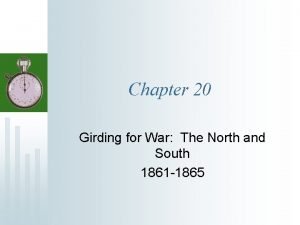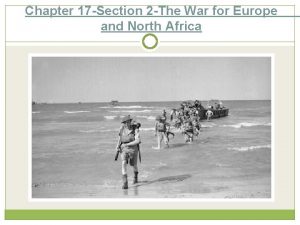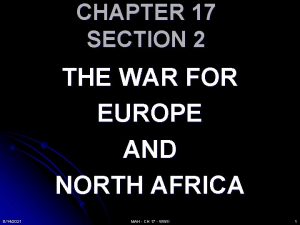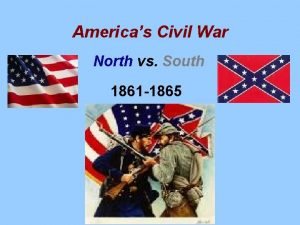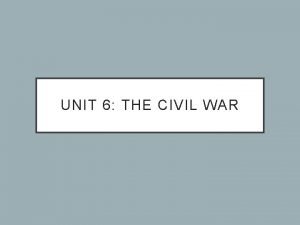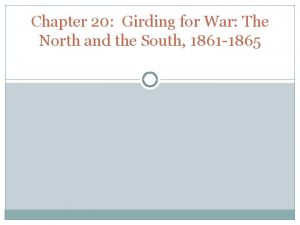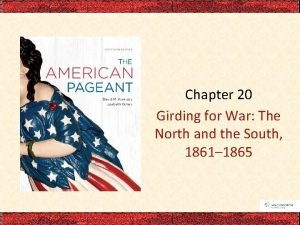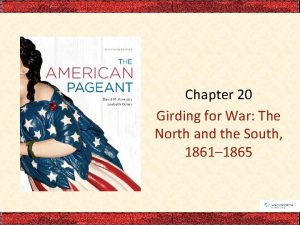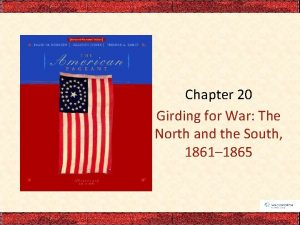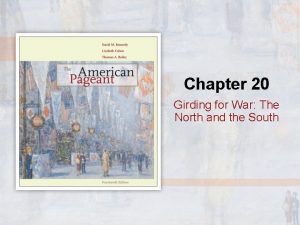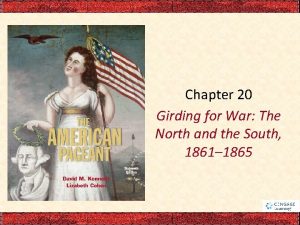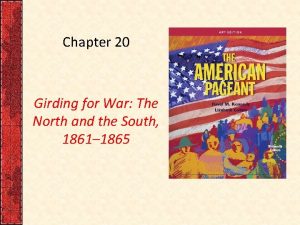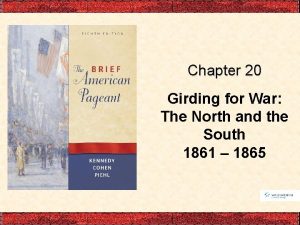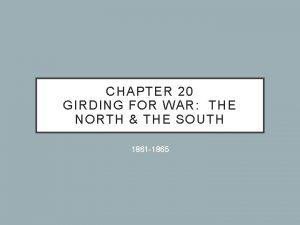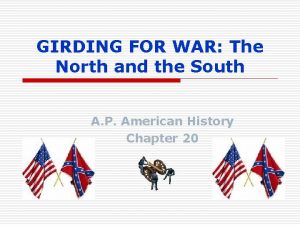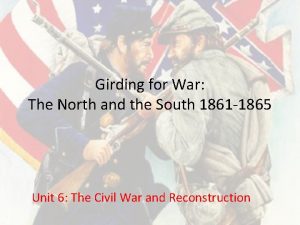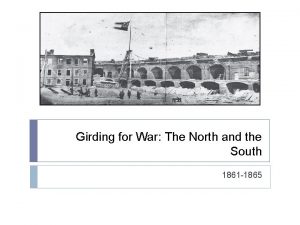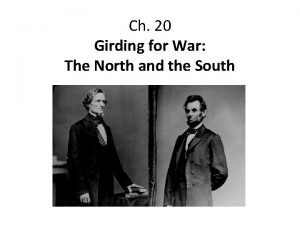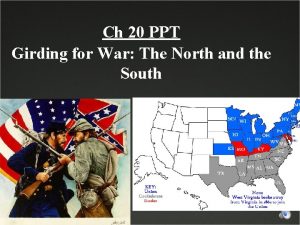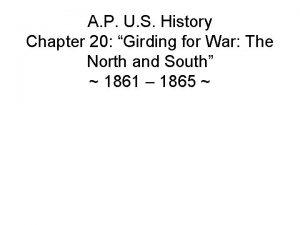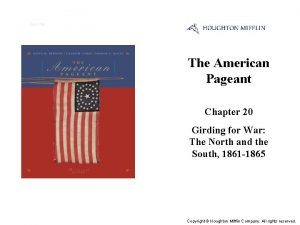Chapter 20 Girding for War The North and






































































- Slides: 70

Chapter 20 Girding for War: The North and the South, 1861– 1865

I. The Menace of Secession • Lincoln’s inaugural address: • Was firm yet conciliatory • There would be no conflict unless the South provoked it • Secession was wholly impractical • The North and South were conjoined twins, bound inseparably together – Concession would create new controversies: • What share of the federal debt should the South be forced to take with it?

I. The Menace of Secession (cont. ) • What portion of the jointly held federal territories should the Confederate states be allotted? • How would the fugitive slave issue be resolved? – A united United States had been the paramount republic in the Western Hemisphere: • If this powerful democracy broke into two hostile parts: – Europeans could transplant their concept of balance of power – They could play the divide and conquer game—creating a dis -United states

p 419

II. South Carolina Assails Fort Sumter – Issue of the divided Union came to a head over the matter of federal forts in the South: • As the seceding states left, they seized the United States’ arsenals, mints and other public property in their borders • Fort Sumter, in Charleston harbor – Short on supply; caused Lincoln to adopt a middle-of-the road solution – He notified South Carolinians that an expedition would be sent to provision the garrison, though not to reinforce it – He promised “no effort to throw in men, arms, and ammunition. ”

II. South Carolina Assails Fort Sumter (cont. ) – To Southern eyes “provision” still spelled “reinforcement” • A Union naval force was next started on its way to Fort Sumter—a move the South regarded as an act of aggression • On April 12, 1861 cannon of the Carolinians opened fire on the fort • After a 34 hour bombardment, no lives taken, the dazed garrison surrendered • The North was electrified and provoked to fighting: – The fort was lost, but the Union was saved. – Lincoln turned a tactical defeat into a calculated victory.

II. South Carolina Assails Fort Sumter (cont. ) – Lincoln (April 15) issued a call to the states for 75, 000 militiamen: • Volunteers sprang to the colors • April 19 and 27, the president proclaimed a blockade of Southern seaports • The call for troops aroused the South • Lincoln was now waging war—from the Southern view an aggressive war—on the Confederacy • Virginia, Arkansas Tennessee reluctantly joined Confederacy, as did North Carolina (see Map 20. 1)

II. South Carolina Assails Fort Sumter (cont. ) – Seven states became eleven as the “submissionists” and “Union shriekers” were overcome – Richmond, Virginia, replaced Montgomery, Alabama, as the Confederate capital—too near Washington for strategic comfort on either side

Map 20 -1 p 420

III. Brothers’ Blood and Border Blood • Border states: – The only slave states left • Missouri, Kentucky, Maryland, Delaware and later West Virginia—the “mountain whites” illegally tore from Virginia in mid-1861 – They contained • White population more than half that of the entire Confederacy • Maryland, Kentucky, and Missouri: double the manufacturing capacity of the South

III. Brothers’ Blood and Border Blood (cont. ) • The strategic prize of the Ohio River flowed along the northern border of Kentucky and West Virginia • Two navigable tributaries, the Cumberland Tennessee Rivers, penetrated deep into Dixie – This same area produced much of the Confederacy’s grain, gunpowder and iron – The Border States • Lincoln successfully used methods of dubious legality • In Maryland he declared martial law • He deployed Union troops to western Virginia and Missouri

III. Brothers’ Blood and Border Blood (cont. ) – An official statement of the North’s war aims was profoundly influential in the Border States • Lincoln declared he was not fighting to free blacks • Antislavery war was extremely unpopular in “Butternut” region of southern Ohio, Indiana, Illinois • This area was settled by Southerners who carried their racial prejudices with them (pp. 236 -237) • Hot-bed of pro-Southern sentiment • The war did not begin between slave soil and free soil

III. Brothers’ Blood and Border Blood (cont. ) – Slavery also colored the character of the war in the West: • Indian territories and tribes sided with Confederacy • The Cherokees owned slaves and had common interest with the South • To secure their loyalty, the Confederate government agreed to take over federal payments to the tribes • And invited the Native Americans to send delegates to the Confederate congress • In return the tribes supplied troops

III. Brothers’ Blood and Border Blood (cont. ) – Some Cherokees—mostly Plain Indians—sided with the Union • The conflict between “Billy Yank” and “Johnny Reb” was a brothers’ war (see pp. 422 -423) • Many Northern volunteers from the Southern states, many Southern volunteers from the Northern states • From the Border States, one brother rode north (Blue) and one brother rode south (Gray)

p 421

IV. The Balance of Forces – First the South seemed to have great advantages: • Could fight defensively behind interior lines • North had to invade the vast unknown Confederacy, conquer it, and drag it back into the Union • South did not have to win the war to win its independence • South fought for self-determination and preservation • South at first enjoyed high morale • Militarily the South had the most talented officers, especially Lee

IV. The Balance of Forces (cont. ) • Ordinary Southerners were bred to fight • The South seemed to be handicapped by the scarcity of factories, but did manage to obtain sufficient weaponry – Southern Drawbacks • Grave shortages of shoes, uniforms, and blankets • The economy was the greatest Southern weakness, but was the North’s greatest strength • The North was not only a huge farm but a sprawling factory (see Table 20. 1)

IV. The Balance of Forces (cont. ) • Yankees boasted ¾ of the nation’s wealth and ¾ of 30, 000 miles of railroads • The North controlled the seas with its superior navy • Northern sea power enabled it to exchange huge quantities of grain for munitions and supplies from Europe • The Union enjoyed a much larger reserve of manpower, 22 million population; seceding states 9 million, including 3. 5 million slaves • North’s overwhelming soldiery were immigrants from Europe pouring into the North (see Table 20. 2)

IV. The Balance of Forces (cont. ) • 1/5 of Union forces were foreign-born and in some units there were four different languages • Ordinary Northern boys were less prepared than Southern counterparts for military life • The North was much less fortunate in its higher commanders – Lincoln used a trial-and-error methods to determine the most effective leaders finally uncovering Ulysses Simpson Grant • The Northern strengths outweighed those of the South

IV. The Balance of Forces (cont. ) • Beginning of the war more favorable for the South to win – The might-have-beens are fascinating: • If the Border States had seceded, • If the uncertain states of the upper Mississippi Valley had turned against the Union, • If a wave of Northern defeatism had demanded an armistice, • And if Britain and/or France had broken the Union’s naval blockade of Southern ports, the South might well have won—but the South could not hope to win.

p 422

p 423

p 424

Table 20 -1 p 425

Table 20 -2 p 425

V. Dethroning King Cotton • Successful revolutions generally succeed because of foreign intervention: – Of Confederacy's potential assets this was the most important—foreign intervention • Europe’s ruling classes were openly sympathetic to the Confederate cause: – They had long abhorred American democratic experiment – They cherished a kind of fellow-feeling for the South’s semifeudal, aristocratic social order

V. Dethroning King Cotton (cont. ) – Northern interests: • The mass of working people in Britain were pulling and praying for the North • They read Uncle Tom’s Cabin and sensed that the war might extinguish slavery if the North emerged victorious – Thus the dead hands of Uncle Tom helped Uncle Sam by restraining the British and French ironclads from piercing the Union blockade. – The British textile mills depended on the American South for 75% of their cotton supplies.

V. Dethroning King Cotton (cont. ) – Why did King Cotton fail the South? • Strong production in the prewar years-1857 -1860, • Enormous exports had piled up surpluses in British warehouses • Later many British workers were unemployed • Direct effects of “cotton famine” were relieved: – Hunger of unemployed workers was partially eased by Americans sending over foodstuffs – Union armies’ victories gave them the cotton to ship to Britain – The Confederates ran a limited quantity through blockades

V. Dethroning King Cotton (cont. ) – Cotton growers in Egypt and India, responding to high prices, increased their output and captured a share of the world cotton markets – Booming war industries in England, which supplied North and South, relieved unemployment • King Wheat and King Corn—the monarch of Northern agriculture—proved more potentates than King Cotton. – North produced bountiful crops of grain and harvested them with Mc. Cormick’s mechanical reaper – Britain was forced to import huge quantities of grain from America—which was cheaper and most abundant

p 426

p 427

VI. The Decisiveness of Diplomacy • Trent affair— – 1861 Union warship in Cuban waters was stopped by the British mail steamer, Trent • Forced removal of two Confederate diplomats bound for Europe • Britons were outraged • Yankees could not boldly offend the Mistress of the Sea • War preparations buzzed • Red-coated troops embarked for Canada

VI. The Decisiveness Diplomacy (cont. ) • Alabama— – Second major crisis in Anglo-American relations: • Over the unneutral building in Britain of Confederate commerce-raiders – The Alabama escaped in 1862 to the Portuguese Azores, loaded weapons and crews from two British ships that followed it – Flying Confederate flags and officered by Confederates, it was manned by Britons and never entered a Confederate port – Britain was the chief naval base of the Confederacy

VI. The Decisiveness Diplomacy (cont. ) • “British pirate” captured over sixty vessels • The Alabama finally accepted a challenge from a stronger Union cruiser off the coast of in 1864 and was quickly destroyed. • The issue of British-built Confederate raiders stay alive. • American minister Charles Francis Adams – prodded the British to perceive that allowing such ships was a dangerous precedent and someday could be used against them

VI. The Decisiveness Diplomacy (cont. ) • Britain could not remain neutral: – Confederate commerce-destroyers, chiefly British-built, captured over 250 Yankee ships – Severely crippling the American merchant marine, which never fully recovered • American looked north and talked about grabbing Canada when the war was over

VII. Foreign Flare-ups • Third and final Anglo-American crisis: – Laird rams—two Confederate warships being constructed in the shipyard of John Laird and Sons in Great Britain • Designed to destroy Union wooden ships with their iron rams and large-caliber guns • Minister Adams warned that “this is war” if the rams were released • The London government relented and bought the two ships for the Royal Navy

VII. Foreign Flare-ups (cont. ) • Britain: – Agreed in 1871 to submit the Alabama dispute to arbitration – And in 1872 paid American claimants $15. 5 million for damages caused by wartime commerce-raiders – American rancor was also directed at Canada: – Where Southern agents plotted to burn Northern cities – One Confederate raid into Vermont left three banks plundered and one American citizen dead

VII. Foreign Flare-up (cont. ) • Dominion of Canada 1867: – Two great nations emerged from the fiery furnace of the Civil War: • One was a reunited United States • The other was a united Canada • Emperor Napoleon III: • Dispatched a French army to occupy Mexico City • Installed a puppet government with Austrian archduke Maximilian as emperor of Mexico

VII. Foreign Flare-up (cont. ) • These two acts were flagrant violations of the Monroe Doctrine – United States gave aid to the resistance movement headed by Mexico’s beloved national hero: Benito Juarez • After the Civil War was over Americans were going to head south to Mexico – Napoleon realized that his costly gamble was doomed – He reluctantly took “French leave” of his puppet gov’t. in 1867 – Maximilian crumpled ingloriously before a Mexican firing squad

VIII. President Davis Versus President Lincoln • The Confederate government weakness: – Its constitution contained one deadly defect • Created by secession, it could not logically deny future secession to its constituent states – President Jefferson want a well-knit central government: opposed by states’ rights – The Richmond regime encountered difficulty persuading certain state troopers to serve outside their own borders

VIII. President Davis Versus President Lincoln (cont. ) • President Davis never enjoyed real personal popularity and was often at loggerheads with his congress – Serious talk of impeachment – He overworked himself – Task proved beyond his powers

VIII. President Davis Versus President Lincoln (cont. ) • Lincoln had his troubles: – More experienced but less flexible than Davis – Able to relax with droll stories at critical times – “Old Abe” grew as the war dragged on – Tactful, quiet, patient, yet firm – He developed a genius for interpreting and leading a fickle public opinion • He demonstrated charitableness toward the South and forbearance toward backbiting colleagues

p 428

IX. Limitations on Wartime Liberties • Congress, in times of crisis, generally accepts or confirms the president's questionable acts • Lincoln did not believe that once the war was over that his ironhanded authority would continue • Congress not in session when war started, so Lincoln gathered the reins into his own hands – Brushing aside legal objections, he boldly proclaimed a blockade – Arbitrarily increased the size of the Federal army— something only Congress can do under the Constitution (see Art. I, Sec. VIII, para 12); Congress later approved

IX. Limitations on Wartime Liberties (cont. ) – Directed the Secretary of the Treasury to advance $2 million without appropriation of security to three private citizens for military purpose: » A grave irregularity contrary to the Constitution (see Art. I, Sec. IX, para. 7) – Suspended the precious privilege of the writ of habeas corpus, so that anti-Unionists could be arrested » Defied a dubious ruling by the chief justice that the safeguards of habeas corpus could be set aside only w/ authorization of Congress (see Art. I. , Sec. IX, para. 2) – His regime was guilty of many other highhanded acts. • Davis was less able than Lincoln to exercise arbitrary power, mainly because of states’ righters.

X. Volunteers and Draftees: North and South • War demanded men—lots of men: – Northern armies first manned solely by volunteers • Each state assigned a quota based on population – 1863 Congress passed the first conscription law • The provisions were grossly unfair to the poor • One could hire a substitute or pay $300 for exemption rights • The draft was especially damned in the Democratic strongholds of the north, notably in New York City

X. Volunteers and Draftees: North and South (cont. ) • Elsewhere in the north, conscription met with resentment and an occasional minor riot • 90% of the Union troops were volunteers • Recruits were found in other places • Deserters were plentiful—the Union army recorded about 200, 000 deserters • Confederate authorities were plagued with a runaway problem of similar dimensions

X. Volunteers and Draftees: North and South (cont. ) • The South: – Relied mainly on volunteers: • Less populous, it scraped the bottom (see Table 20. 3) • The Richmond regime robbed both “cradle and grave” (age seventeen to fifty); was forced to resort to conscription as early as 1862 – Nearly a year before the Union – Confederate draft regulations worked serious injustices

X. Volunteers and Draftees: North and South (cont. ) • A man could hire a substitute or purchase exemption • Slaveowners or overseers with twenty slaves might also claim exemption • Confederation conscription agents avoided areas inhibited by sharpshooting mountain whites

p 430

p 430

Table 20 -3 p 431

XI. The Economic Stresses of War • Northern economies: – Blessed with a lion’s share of the wealth • Excise taxes on tobacco and alcohol were increased by Congress • An income tax was levied for the first time • Customs receipts proved important revenue-raisers – Congress 1861 passed the Morrill Tariff Act: • Increased duties some 5 to 10 percent, • Soon pushed upward by the necessities of war

XI. The Economic Stresses of War (cont. ) – Partly to raise revenue – Partly to provide more protection for the prosperous manufacturers who were being plucked by the new internal taxes • A protective tariff became identified with the Republican party, as American industrialists were mostly Republican. – Greenbacks: • Washington Treasury issued paper money, totaling nearly $450 million at face value – Printing-press currency was inadequately supported by gold, hence its value was determined by the nation’s credit

XI. The Economic Stresses of War (cont. ) – Bonds: • Government netted $2, 621, 916, 786 from the sale of bonds • Method of sale was through “drives” and payroll deductions had not been devised • The Treasury was forced to market its bonds through private banking house of Jay Cooke and Company, which received a commission of three-eights of 1% • Profits and patriotism at stake, the bankers succeeded in making effective appeals to citizen purchasers

XI. The Economic Stresses of War (cont. ) • National Banking System – Financial landmark of the war • Authorized by Congress in 1863 • Launched as a stimulant to the sale of government bonds • Also designed to establish a standard bank-note currency – Banks that joined the National Banking System could buy government bonds and issue sound paper money backed by them

XI. The Economic Stresses of War (cont. ) – The first significant step toward a unified banking network since 1836: • Existed for 50 years, then replaced by the Federal Reserve System in 1913. • Southern financial woes: – Custom duties were cut off by Union blockade – Confederate bonds sold amounting to $400 million – Increased taxes sharply and imposed a 10% levy on farm produce

XI. The Economic Stresses of War (cont. ) – The government was forced to print blue-backed paper money – “Runaway inflation” occurred with backed treasury notes, totaling more than $1 billion. • These eventually sank to be worth only 1. 6 cents. • The war inflicted a 9, 000% inflation rate on the Confederacy, contrasted with 80% for the Union.

XII. The North’s Economic Boom • Wartime prosperity in the North was little short of miraculous: – New factories, sheltered by the new protective tariffs, mushroomed • Soaring prices pinched the day laborer and the whitecollar worker to some extent • But the manufacturers and businesspeople raked in “the fortunes of war. ”

XIII. The North’s Economic Boom (cont. ) – The Civil War bred a millionaire class for the first time in American history: • Graft was more flagrant in the North partly because there was more to steal • Yankee “sharpness” appeared at its worst – Newly invented laborsaving machinery enabled the North to expand economically • Even though war drained off manpower • The sewing machine wrought wonders in fabricating uniforms and military footwear

XIII. The North’s Economic Boom (cont. ) • The marriage of military need and innovative machinery largely ended the production of customtailored clothing – Graduated standard measurements were introduced • Mechanical reapers numbered 250, 000 by 1865 – Released tens of thousands of farm boys for the army and fed them their field rations – Produced vast surpluses of grain that were sent abroad – Helped dethrone King Cotton – Provided profits to buy munitions and supplies from abroad – Contributed to the prosperity of the North—a prosperity that enabled the Union to weather the war

XIII. The North’s Economic Boom (cont. ) • Other industries were humming: – Discovery of petroleum (1859) • Lead to the “Fifty-Niners” to Pennsylvania • Birth of the “petroleum plutocracy” and “coal oil Johnnies” – Pioneers continued to push westward • Estimated 300, 000 • Homestead Act (1862). – Only the ocean-carrying trade suffered a crippling setback

XIII. The North’s Economic Boom (cont. ) • The Civil War was a women’s war, too: • Women often took men’s jobs as they went off to war • In Washington, D. C. , 500 women clerks became government workers, with over 100 in the Treasury Department • Countless women were drawn into industrial employment • Some stepped up to the fighting front – Dr. Elizabeth Blackwell, America’s first female physician helped organize the U. S. Sanitary Commission to assist the Union armies in the field

XIII. The North’s Economic Boom (cont. ) – U. S. Sanitary Commission: • Trained nurses, collected medical supplies, and equipped hospitals • Helped women to acquire the organizational skills and the self-confidence that would compel the women’s movement • Clara Barton and Dorothea Dix helped transform nursing into a respectful profession • Equally renowned was Sally Tompkins, who ran an infirmary for wounded Confederate soldiers. – Women organized bazaars and fairs to raise money.

p 432

p 432

XIII. A Crushed Cotton Kingdom • The South fought to the point of exhaustion: – Losses suffered by destruction wrought by invaders and suffocation of the blockade – Possessing 30% of the national wealth (1860), the South claimed only 12% in 1870 – The Civil War squeezed the average Southern income to 2/5 of the Northern level – The South’s bid for independence exacted a cruel and devastating cost

XIII. A Crushed Cotton Kingdom (cont. ) – Transportation collapsed • Driven to economic cannibalism of pulling up rails to repair main ones – Window weights were melted down into bullets – Gourds replaced dishes and pins were reluctantly loaned. • To the brutal end, the South mustered remarkable resourcefulness and spirit – Women buoyed up their menfolk

XIII. A Crushed Cotton Kingdom (cont. ) – A proposal was made that women cut their long hair and sell it abroad—blocked by the blockade – Women took pride in denying themselves the silks and satins of their Northern sisters • At war’s end the Northern Captains of Industry had conquered the Southern Lords of the Manor

p 434
 Chapter 20 girding for war the north and the south
Chapter 20 girding for war the north and the south The war for europe and north africa chapter 17 section 2
The war for europe and north africa chapter 17 section 2 The war for europe and north africa chapter 17 section 2
The war for europe and north africa chapter 17 section 2 Chapter 30 the war to end war
Chapter 30 the war to end war Chapter 30 the war to end war
Chapter 30 the war to end war Integrated care system north east
Integrated care system north east Chapter 14 lesson 1 the industrial north
Chapter 14 lesson 1 the industrial north North and south states civil war
North and south states civil war North and south states civil war
North and south states civil war True north vs magnetic north
True north vs magnetic north The north pole ____ a latitude of 90 degrees north
The north pole ____ a latitude of 90 degrees north Chapter 16 lesson 2 challenges to slavery
Chapter 16 lesson 2 challenges to slavery Causes of civil war
Causes of civil war North vs south civil war
North vs south civil war James madison war at home
James madison war at home Korean war vietnam war venn diagram
Korean war vietnam war venn diagram The cold war lesson 1 the cold war begins
The cold war lesson 1 the cold war begins Comparing reconstruction plans venn diagram
Comparing reconstruction plans venn diagram Josette dugas war of 1812
Josette dugas war of 1812 War warst war
War warst war Force and motion study jams
Force and motion study jams Civil war first modern war
Civil war first modern war Bringen pasado simple
Bringen pasado simple Cold war proxy wars
Cold war proxy wars Kontinuitetshantering
Kontinuitetshantering Novell typiska drag
Novell typiska drag Nationell inriktning för artificiell intelligens
Nationell inriktning för artificiell intelligens Vad står k.r.å.k.a.n för
Vad står k.r.å.k.a.n för Varför kallas perioden 1918-1939 för mellankrigstiden?
Varför kallas perioden 1918-1939 för mellankrigstiden? En lathund för arbete med kontinuitetshantering
En lathund för arbete med kontinuitetshantering Kassaregister ideell förening
Kassaregister ideell förening Personlig tidbok
Personlig tidbok A gastrica
A gastrica Densitet vatten
Densitet vatten Datorkunskap för nybörjare
Datorkunskap för nybörjare Tack för att ni lyssnade bild
Tack för att ni lyssnade bild Att skriva debattartikel
Att skriva debattartikel Autokratiskt ledarskap
Autokratiskt ledarskap Nyckelkompetenser för livslångt lärande
Nyckelkompetenser för livslångt lärande Påbyggnader för flakfordon
Påbyggnader för flakfordon Tryck formel
Tryck formel Svenskt ramverk för digital samverkan
Svenskt ramverk för digital samverkan Lyckans minut erik lindorm analys
Lyckans minut erik lindorm analys Presentera för publik crossboss
Presentera för publik crossboss Jiddisch
Jiddisch Kanaans land
Kanaans land Klassificeringsstruktur för kommunala verksamheter
Klassificeringsstruktur för kommunala verksamheter Luftstrupen för medicinare
Luftstrupen för medicinare Claes martinsson
Claes martinsson Centrum för kunskap och säkerhet
Centrum för kunskap och säkerhet Lågenergihus nyproduktion
Lågenergihus nyproduktion Mat för idrottare
Mat för idrottare Verktyg för automatisering av utbetalningar
Verktyg för automatisering av utbetalningar Rutin för avvikelsehantering
Rutin för avvikelsehantering Smärtskolan kunskap för livet
Smärtskolan kunskap för livet Ministerstyre för och nackdelar
Ministerstyre för och nackdelar Tack för att ni har lyssnat
Tack för att ni har lyssnat Mall för referat
Mall för referat Redogör för vad psykologi är
Redogör för vad psykologi är Borstål, egenskaper
Borstål, egenskaper Atmosfr
Atmosfr Borra hål för knoppar
Borra hål för knoppar Orubbliga rättigheter
Orubbliga rättigheter Stickprovsvariansen
Stickprovsvariansen Tack för att ni har lyssnat
Tack för att ni har lyssnat Rita perspektiv
Rita perspektiv Ledningssystem för verksamhetsinformation
Ledningssystem för verksamhetsinformation Tobinskatten för och nackdelar
Tobinskatten för och nackdelar Toppslätskivling effekt
Toppslätskivling effekt Gibbs reflekterande cykel
Gibbs reflekterande cykel Egg för emanuel
Egg för emanuel
